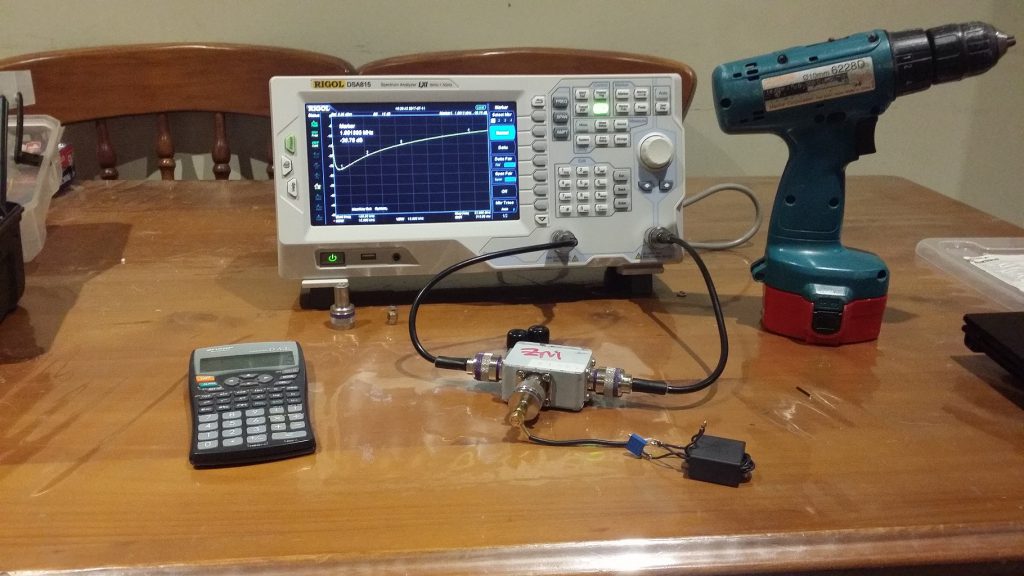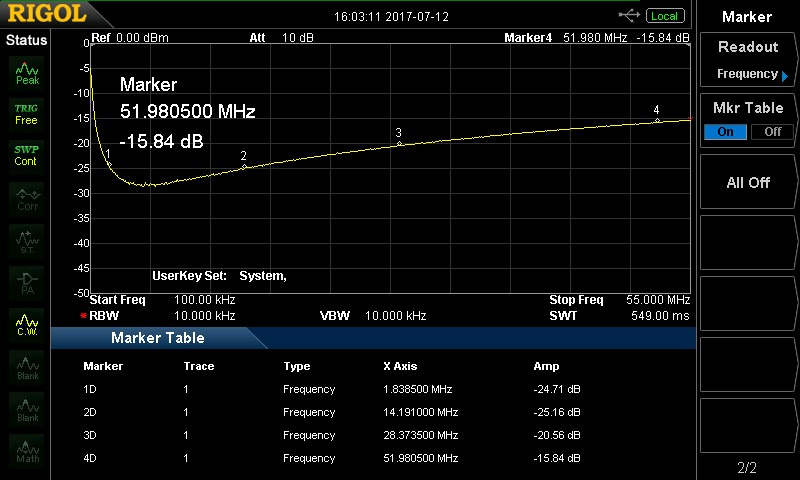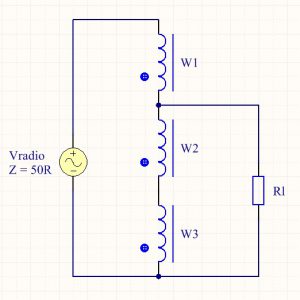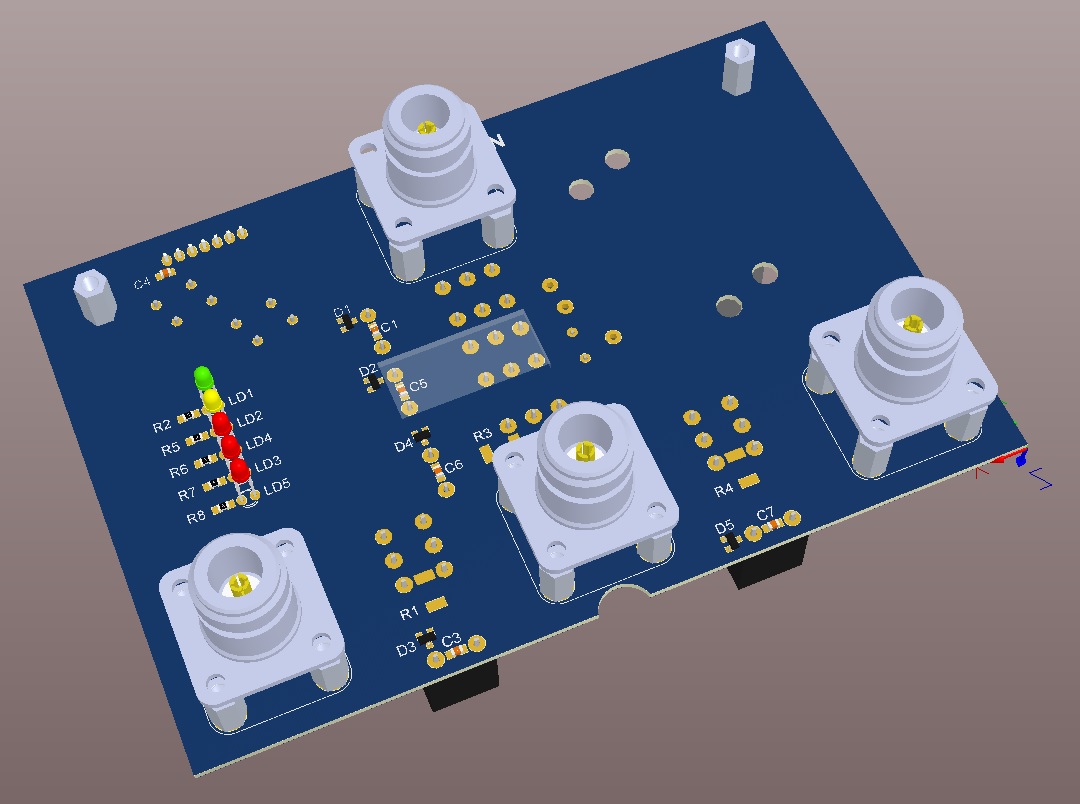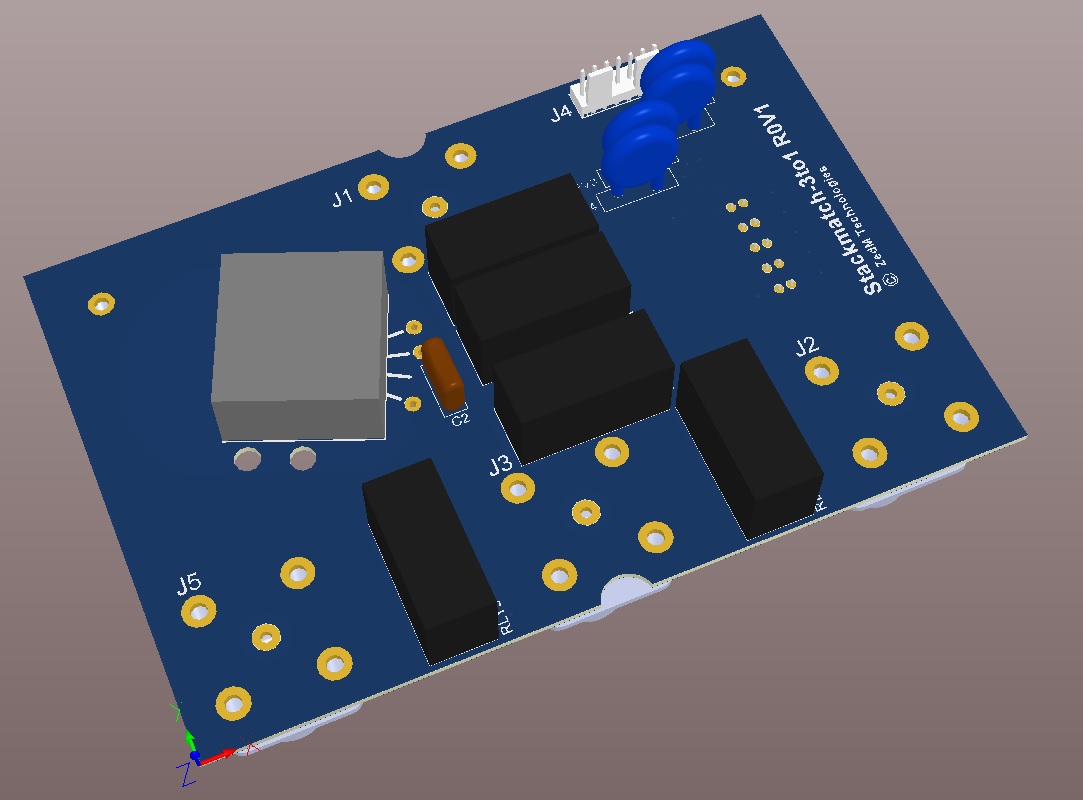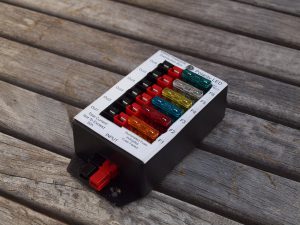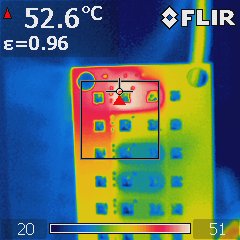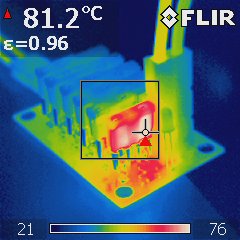Well the Stackmatch PCB’s finally came back from the Manufacturer along with the components from Mouser, so it was time to build. I’m pleased with the 3D model and the actual final assembly, they are pretty close !
I’ve not mounted the LED’s on the left hand side yet, this will wait until I can drill the front panel of the diecast enclosure and begin final assembly. Since I’ve got more than one of these to make I’m getting a template made from steel that I can mount on the front panel and then drill all the holes.
The assembly in the picture above is the first prototype and I wasn’t going to wait for the front panel and die-cast box to be ready before testing. The connectors have been attached at roughly the right height using an additional nut as a spacer, I’ve only fitted half the standoffs to save some time.
So the question is does it work?
The first test is simply a test of the isolation between ports. So taking a spectrum analyser with tracking generator the idea is to measure the insertion loss between the input and one output as we switch between all three outputs one at a time and record the results. All outputs are terminated in a 50 ohm load. What is interesting with this stackmatch is we can also select “no outputs” where no relays are energised, this has a surprising result on the measured isolation;
OK, so what can we deduce from these series of plots. The Spectrum analyser (SA) tracking generator was on the Stackmatch input, the SA input was on Output #1 unless you missed it. As we switch each output from #1 to #3 we can see the insertion loss change. As you would expect when we select output #1 we measure the insertion or through loss of the stackmatch, when we select any output other than #1 we measure the Isolation between ports.
Here’s the all important worst case summary, which is of course at the high end of the HF band i.e 10m;
- Insertion Loss < -0.2dB
- Isolation > 37dB
That is not too bad for a single device covering from 160m to 10m. In real terms it means when we are transmitting 400W PEP (+56dBm) on 10m that less than 80mW (+19dBm) will be leaking out the other two ports. The same can be said for helping prevent overload in the receiver from adjacent contest stations (i.e. on 20m). The AREG typically use Elecraft K3’s and high end Icom transceivers so these typically don’t give too hoots about QRO contest stations on adjacent bands in the first place. The best part is as we go lower in frequency the Isolation increases a further 10dB which can only improve the situation.
The insertion loss is barely measurable, so nothing should be getting really hot or require further bypassing.
Now what was also interesting is the difference in output isolation with no outputs being selected and just one. The isolation to an unused port increased by +5dB to +6dB when the input was terminated into just one antenna. That is something that we’ll need to take care of with our control system, not selecting any output is bad.
So then it was a question of moving the Spectrum Analyser input to Port #2, terminating Port #1 and repeating the above measurements again. We do the same again for Port #3, shuffling the dummy loads and measuring once more. I’ll not bother putting up all of these plots, suffice to say all of the isolation between ports were within 0.5dB of each other and insertion loss didn’t move.
Now for the main event, parallel combinations.
To do this we use a Return Loss (RL) measurement, so I’ve placed the RL bridge on the input to the Stackmatch and then terminated every output in a good quality dummy load, this is important !. Then by switching the outputs in succession I can generate the various parallel combinations (25 ohms and 16.7 ohms) and then switch the transformer into to see the effect. In all cases a 30pF Silver Mica cap has been tacked across the output of the auto transformer as per our previous experiment (click). Here’s the measured plots;
So from our first plot where only one output is selected our return loss looks excellent with the minor exception of a spike at 8MHz. I’m not sure that this is real just yet and will be doing some further work on what that resonance could be. It’s got to be a parasitic capacitance there somewhere, will track that down later. You might notice that the RL is better than -20dB (1.2:1) anyway, so a moot point really.
When we place output #1 and #2 in parallel we get 25 ohms and the RL rises to -10dB as you’d expect. Then when we kick in the transformer we see an immediate improvement of RL to better than -18dB (1.3:1) at worst case (10m).
Now when we place all three outputs in parallel our RL is destroyed -6dB, but again if we kick in the transformer we see an improvement in RL of -13.5dB (1.6:1). If you get your calculator out you find the ratios are smack bang on our design of 2.25:1. So to summarise;
- Return Loss (1-output) < -20dB
- Return Loss (2-output) < -18dB
- Return Loss (3-output) < -13dB
Yaay it works !
So there we have it, the beginnings of a workable stackmatch design. As with any new design there is still plenty to be tweaked and played with. In the coming weeks I’ll be;
- investigating the effect of the cap across the output
- chasing down that odd parasitic resonance at 8MHz with one antenna selected
- measuring the temperature rise of the transformer with 120W of CW being blasted into it, or 300W of RTTY to give it some real curry…
- Making the final enclosures and seeing what effect (if any) this has on the design
- Trying #16, #20 & #24 gauge PTFE wire on the same core to see if the performance or characteristics of the transformer changes
- Seeing what effect the +/- J term from various antennas has on the combined feed point impedance that our radio will see (thanks to David VK5DGR for bringing that one up !)
Yes it’s going to be a busy few months as we explore what this new toy can do.

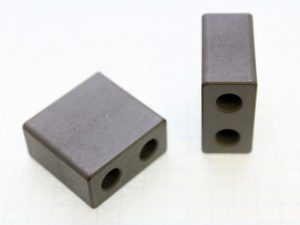 Many stackmatch designs use a toroid core, but I’ve decided to instead investigate using a multi-aperture “binocular” core.
Many stackmatch designs use a toroid core, but I’ve decided to instead investigate using a multi-aperture “binocular” core.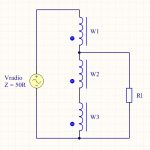 The transformer is wound the same way as if on a toroid, so take three wires, twist them together (battery drill helps) and wind the desired number of turns through the holes. It seems sensible to start with a full core and take turns off if I achieved too much inductance. Both of these cores hold ~4 turns of trifiliar wound 20AWG silver plated PTFE wire, it might add the last turn is hard to do. All that is left is to series up the windings and tap at the appropriate positions, the schematic is to the right.
The transformer is wound the same way as if on a toroid, so take three wires, twist them together (battery drill helps) and wind the desired number of turns through the holes. It seems sensible to start with a full core and take turns off if I achieved too much inductance. Both of these cores hold ~4 turns of trifiliar wound 20AWG silver plated PTFE wire, it might add the last turn is hard to do. All that is left is to series up the windings and tap at the appropriate positions, the schematic is to the right.